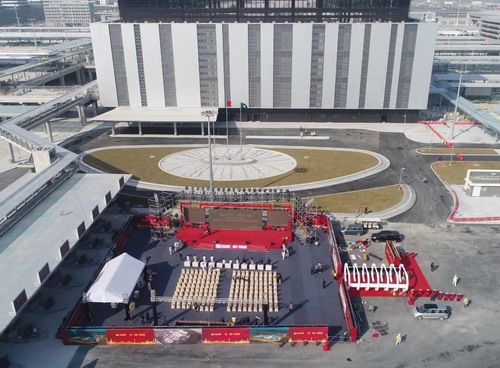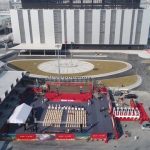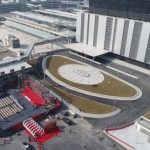 The Macao boundary crossing area of the Hong Kong-Zhuhai-Macao (HKZM) Bridge.
The Macao boundary crossing area of the Hong Kong-Zhuhai-Macao (HKZM) Bridge.
The Government is dedicating all-out effort to realise its goal for completion – before year-end – of the fundamentals of the Macao boundary crossing area of the Hong Kong-Zhuhai-Macao (HKZM) Bridge.
Construction of the Macao boundary crossing structure for the Bridge is near an end and its facilities are ready to put into trial operation, following a lighting ceremony held on Monday (18 December) in Zhuhai by the Macao SAR Government to mark such milestone.
The Government will closely liaise with Hong Kong and Guangdong authorities on the exact date of the launch of the cross-delta bridge, which is to be approved by the Central Government.
Construction of Macao’s boundary crossing area is on schedule. The structure will enter in operation on the same day the Bridge is opened to traffic.
The Macao boundary crossing area is an important part of the Hong Kong-Zhuhai-Macao Bridge and a significant project for the Macao Government. The boundary crossing area is a crucial infrastructure in order for Macao to take part in the “Belt and Road” initiative and the development of the Guangdong-Hong Kong-Macao Greater Bay Area.
Construction of the Macao boundary crossing area, located on one of the Bridge’s two artificial Islands commenced in December 2016. The Macao boundary area covers 71.6 hectares, including a six-storey building for customs clearance; and two public car parks – located respectively at the east and west end of the artificial island – with a total of 6,800 spaces for private vehicles and another 2,000 for motorcycles.
Facilities at the Macao boundary area also comprise: 53 buildings for municipal use; and around 200,000 square metres of space dedicated to infrastructure including the road network, tunnels, flyovers, and railway platforms.
Efficient management of Macao’s boundary crossing area is an important matter under the Guangdong-Macao cooperation. An agreement, endorsed by both the Guangdong Provincial Government and the Macao Government, commissioned Nam Kwong (Group) Company Limited to build and manage the area. Macao’s boundary crossing area is the largest in terms of gross floor area within the HKZM Bridge, namely compared to the boundary crossing areas of, respectively, Hong Kong and Zhuhai. Construction of Macao’s boundary crossing area had to be completed in a short period of time. It involved a total budget of 10 billion patacas.
Regarding cross-boundary transport services, it is anticipated there will be shuttle buses running between the Macao and Hong Kong boundary crossing areas, and between the Hong Kong and Zhuhai boundary areas.
Macao-Hong Kong cross-boundary transport services fall into the following categories: trucks, buses; taxis; and private vehicles. The latter three categories are subject to quotas in terms of right of use.
Regarding Hong Kong-Macao bus services, there will be an aggregate of 50 quota rights to operate services on a daily basis, i.e. 34 for Hong Kong entities and 16 for Macao entities.
The respective Macao and Hong Kong authorities will announce more details in due course once decisions on quotas for taxi services and for private vehicles are made.
Customs clearance between Macao and Zhuhai will be carried out on a “Joint Inspection and One-time Release” principle, in order to make the process efficient for travellers using the Hong Kong-Zhuhai-Macao Bridge.
Under the new inspection system, travellers will be required to pass border controls only once, in order to complete the departure and arrival formalities.
Details of customs clearance will be announced soon by the Hong Kong-Zhuhai-Macao Bridge Authority.
View gallery


